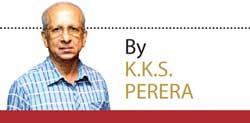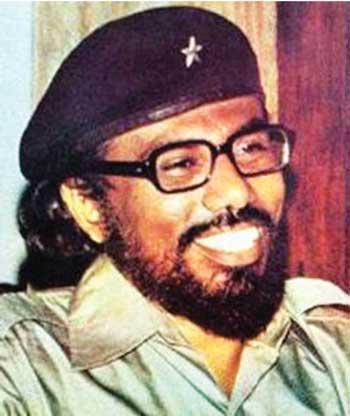06 Apr 2021 - {{hitsCtrl.values.hits}}
 “Let the revolution of the workers, farmers and soldiers be triumphant” Wijeweera at Hyde Park--27 February 1971 Exactly Fifty years ago, April 5, 1971, a Monday and an auspicious day is well etched on my memory for two conflicting emotions. Our home was full of activity with arrangements being finalised to receive a party from Kurunegala for my niece’s Engagement. Soon after the ceremonial “exchange of rings” the lunch table was being laid for the visitors when the Radio Ceylon in its midday news announced that the Wellawaya Police Station had been attacked by Che-Guevaras [as JVPers were known then], with a warning from the police of possible spread of subversive activities. The title speaks of the coded message in the telegrams sent from Colombo to provincial leaders indicating the date of attack.
“Let the revolution of the workers, farmers and soldiers be triumphant” Wijeweera at Hyde Park--27 February 1971 Exactly Fifty years ago, April 5, 1971, a Monday and an auspicious day is well etched on my memory for two conflicting emotions. Our home was full of activity with arrangements being finalised to receive a party from Kurunegala for my niece’s Engagement. Soon after the ceremonial “exchange of rings” the lunch table was being laid for the visitors when the Radio Ceylon in its midday news announced that the Wellawaya Police Station had been attacked by Che-Guevaras [as JVPers were known then], with a warning from the police of possible spread of subversive activities. The title speaks of the coded message in the telegrams sent from Colombo to provincial leaders indicating the date of attack.
Later in the night they attacked and overran 73 police stations using home-made hand grenades and a few shotguns killing 39 Policemen. Within two to three days, insurgents managed to capture power over 33 police areas, had partial control over 40 sub-urban towns and many villages, and damaged another 88 police stations. The defence forces which were caught unprepared were very slow in responding to suppress the armed struggle by the rebels. They captured and held several rural areas for more than a few weeks until they were recaptured by the forces. Some 5,000 were arrested, over 50 security forces men died and, 45 civilians were killed, the injured exceeded 500. It is estimated that around 7,000 youth who took up arms against the state were also killed by Police and security forces in a poorly coordinated plan. Many district leaders were unaware of the decision until the morning of the uprising. Insurrection commenced at 5.20 am on 5 April with Wellawaya Police Station attack that killed two police constables.
 The first armed revolt was carried out by the Marxist (JVP) under the leadership of Rohana Wijeweera, a former medical student from a Russian University and a former member of the Communist Party (Chinese Wing), against the Government of Prime Minister Sirimavo Bandaranaike elected with the help of JVP. Coincidentally, nine years before in January 1962, an attempted Coup d’état by a few military and police officers was aborted by her. Wijeweera and three of his comrades expelled from the party by its head Shanmugathasan over ideological disagreements, formed his own movement in 1965. Working hard on this tricky task he visited every nook and corner of the island in an effort to strengthen the movement through discussion with like-minded youth. On one such occasion, he and another [was it Loku Athula?] visited Siyambalanduwa in an economically backward Monaragala District in the late hours for an overnight meeting with a few of his former Maoist colleagues in Communist Party. While having a light dinner, the two sharing a pol-roti and a single cup of plain tea, quite surprisingly another group of Shan loyalists ‘raided’ the venue and took the two rebels to task harshly and chased them away. Wijeweera with his friend travelled all the way back discarding his worn-off rubber slippers that gave way, as they covered some sixty kms by foot to reach Wellawaya by morning. There were no Dollar funds or SUV luxuries then.
The first armed revolt was carried out by the Marxist (JVP) under the leadership of Rohana Wijeweera, a former medical student from a Russian University and a former member of the Communist Party (Chinese Wing), against the Government of Prime Minister Sirimavo Bandaranaike elected with the help of JVP. Coincidentally, nine years before in January 1962, an attempted Coup d’état by a few military and police officers was aborted by her. Wijeweera and three of his comrades expelled from the party by its head Shanmugathasan over ideological disagreements, formed his own movement in 1965. Working hard on this tricky task he visited every nook and corner of the island in an effort to strengthen the movement through discussion with like-minded youth. On one such occasion, he and another [was it Loku Athula?] visited Siyambalanduwa in an economically backward Monaragala District in the late hours for an overnight meeting with a few of his former Maoist colleagues in Communist Party. While having a light dinner, the two sharing a pol-roti and a single cup of plain tea, quite surprisingly another group of Shan loyalists ‘raided’ the venue and took the two rebels to task harshly and chased them away. Wijeweera with his friend travelled all the way back discarding his worn-off rubber slippers that gave way, as they covered some sixty kms by foot to reach Wellawaya by morning. There were no Dollar funds or SUV luxuries then.
Initially identified as the New Left, Wijeweera changed his strategy, modelled himself on Che Guevara, the Cuban revolutionary to draw unemployed youths and students from rural areas by targeting the 16 to 20-year-olds who could be easily convinced or brain-washed. The rural districts were highly undeveloped, a crisis that contributed to the uprising. Caste conflicts, lack of opportunities for education, and unemployment remained other main issues.
The economic interests of this age group felt they had been neglected by the traditional leftist parties who were in coalition with ‘capitalists’ SLFP. The so-called “Five Lectures-Programme” intended on conversion included ‘economic crisis’ — problems faced by the peasants and the worker; ‘Independence’ —historical background of colonial rule; ‘Indian expansionism’ —the Left movement —the failure of the Old Left and ‘the Revolutionary path. Within two years the group expanded swiftly, winning control of the student movement at all university campuses forming the Socialist Student Union. It had sympathisers within the forces and police who helped them collect sketches of airports, military facilities and police stations that were vital for the success of the ‘revolt’.
In 1969 at a meeting held in Madampella, a Central Committee was formed. Above it was the Politburo made up of 12 including Wijeweera. In the meantime based on intelligence reports, the government appointed a special CID unit under an ASP to conduct investigations. A rapid expansion was witnessed during this period with many radical elements like DIG Dharmasekhara, a popular youth leader of the Maoist Youth Front fame joining hands with the movement. JVP cadres campaigned for the United Front of Sirimavo during the 1970 elections, but the subversive nature of a pamphlet issued by them was used by the UNP administration to have Wijeweera arrested before the elections in May; however, Sirimavo after winning in May ordered his release. Wijeweera intensified the preparations for a revolt by accumulating necessary weapons by raising funds through a string of robberies, such as the Badulla mailbag robbery, the York Street robbery and Okkampitiya bank robbery. They manufactured their own bombs using discarded condensed milk cans and continued arming itself to launch a Guerrilla type revolution. Several camps taught Marxism-Leninism and provided a basic training in military skills.
Following the aborted coup in 1962, the armed forces functioned assisting the Ceylon Police Force, in internal security. Prior to this, they were ill-equipped having only World War II- weapons, armoured cars, mortars and not geared up for a large scale rebellion. It lacked other modern weapons; Royal Ceylon Navy, had suffered most out of the coup with no new recruitments, had only a single frigate.
In spite of warnings of the preparations by the JVP, the government failed to comprehend the degree of the attacks that was about to unfold. The government was anxious of a potential coup led by officers loyal to the previous administration. Bandaranaike’s relatives Captain Ratwatte was promoted Lieutenant Colonel and Captain Denzil Kobbekaduwa led the investigations reported substantial threat posed by the JVP.
Wijeweera was arrested on March 13, and transferred to the Jaffna Prison; three days later a state of emergency was declared. Rebels led by Lionel Bopage, Jayadeva Uyangoda, Sunanda Deshapriya, and Loku Athula, decided to send 500 cadres to Jaffna to break Wijeweera out of prison. All neighbouring nations responded favourably to Sirimavo’s distress call.
Though a Maoist, Wijeweera had reservations about the people’s war theory being applied here. Instead, he wanted to attack police stations and some military units throughout the country and seize power in a surprise strike. Was he influenced by the Zanzibar Revolution eight years ago where Abeid Karume successfully launched an attack on police stations with 700 insurgents to topple the government. But were ill-prepared on many fronts. Things were to change in March 1971. Dharmasekara, who severed relations with Wijeweera led a group of followers and attacked the US Embassy in Colombo, murdering a policeman in the melee. There was suspicion with rumours afloat of a possible mass attack for the security establishment to become more alert.
March 16, the government had declared a state of Emergency under which wide powers including the authority to dispose of bodies without postmortems being conducted were given to the police and the armed forces. As police started arrests, on April 2, the JVP politburo receiving a message from Wijeweera met at the Vidyodaya University and decided to launch the attacks on April 5, at 11:30 pm. Wijeweera had other problems that motivated him to launch it soon for he was under threat from his rivals like Dharmasekara, Sarath Wijesuriya and Loku Athula, who headed the armed wing of the movement. It was a miscommunication of orders that cadres attacked the Wellawaya Police Station in the wee hours on April 5, allowing ample time for counteracts by forces. The same evening IGP messaged police stations of the impending threat after imposing Curfew in Colombo.
In 1987-89 JVP was better prepared and more deeply rooted than that of 1971. The loss of human life and adverse effects on economy in both disasters was extremely high. JVP twice won the Tissamaharama Pradeshiya Sabha. The 50-year-old party in coalition with SLFP in 2004, won 40 seats at Parliamentary elections; but subsequently lost Tissa PS at the last 2018 LG elections and only a single member was elected [to Panadura PS] out of some 8,000 representatives elected.
The JVP have joined the democratic mainstream and will stick to peaceful methods playing many constructive deeds like in passing the 17th Amendment. They, contribute well with effective agitation campaigns though numbers in legislature reduced to three. Both Governments opened their eyes, brought in reforms, with no firm commitment in implementation.
It’s half a century since it happened and a lot of water has gone under the bridge. Tens of thousands of Appuhamis Expired in ‘71 and ‘88/89.
My niece, now a grandma lives happily with her hubby in Kurunegala.
Writer can be contacted at [email protected]
29 Nov 2024 2 hours ago
29 Nov 2024 4 hours ago
29 Nov 2024 5 hours ago
29 Nov 2024 5 hours ago
29 Nov 2024 6 hours ago